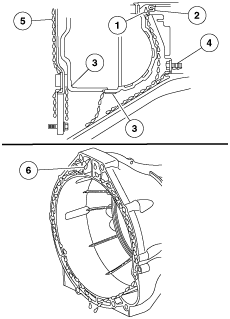 |
LEAKAGE INSPECTION [5R55S]
id0513c1249600
Leak Check Test with a Black Light
1. Add Automatic Transmission/Power Steering Dye to the transmission fluid. Use one 30.0 mL {30.0 cc, 1 ft oz}of dye solution for every 3.8 L {4.0 US qt, 3.3 lmp qt} of transmission fluid.
2. Start and run the engine until the transmission reaches its normal operating temperature.
3. Observe the back of the cylinder block and top of the torque converter housing for evidence of fluid leakage.
4. Raise the vehicle on a hoist.
5. Run the engine at fast idle, then at engine idle, occasionally shifting to the D range and R position to increase pressure within the transmission.
6. Observe the front of the flexplate, back of the cylinder block (in as far as possible), inside the torque converter housing and the entire case until fluid leakage is evident and the probable source of leakage can be detemined.
External fluid leaks
|
Leak path |
Possible source |
|---|---|
|
Leaks at the fluid pan-to-case
|
• Pan bolts not tightened to specification.
• Case pan rail damaged.
• Pan gasket damaged.
|
|
Fluid cooler lines or fittings leaking
|
• Cooler line(s), cooler line fitting(s) damaged.
• Cooler line fittings-to-case union damaged.
• Case damage at case fitting.
• Fittings not tightened to specifications.
|
|
Fluid cooler line nut-to-case fittings leaking
|
• Damaged or missing O-rings.
• Fittings not tightened to specifications.
|
|
Leaks at the fluid cooler
|
• Fluid cooler damage.
• Fitting(s) damaged or not tightened to specifications.
|
|
Leaks at the external sensors
|
• Damaged or missing O-rings.
• Screw not tightened to specifications.
|
|
Leaks at the manual control lever seal
|
• Damaged or missing lever seal.
|
|
Leaks at the solenoid body harness connector
|
• Install a new solenoid body wiring harness connector O-ring seal. Either on the wiring harness end or the solenoid body.
|
|
Fluid leakage in the torque converter area
|
• For possible sources refer to Fluid Leakage In Torque Converter Area Chart.
|
Fluid Leakage in Torque Converter Area
absggw00001754
|
|
Leak path |
Symptom |
Possible source |
|---|---|---|
|
1, 2 and 4
|
Leak at front of transmission
|
Pump lip seal
|
|
1, 2 and 4
|
Leak at front of transmission
|
Converter hub weld
|
|
1, 2 and 4
|
Leak at front of transmission
|
External pump seal (large)
|
|
1, 2 and 4
|
Leak at front of transmission
|
Pump-to-case screws
|
|
1, 2 and 4
|
Leak at front of transmission
|
Pump gasket
|
|
3
|
Leak at front of transmission
|
Torque converter seal weld
|
|
3
|
Leak at front of transmission
|
Torque converter stud
|
|
5
|
Leak at front of transmission
|
Engine oil leak—rear main seal
|
|
5
|
Leak at front of transmission
|
Engine valve cover
|
|
5
|
Leak at front of transmission
|
Oil galley
|
|
5
|
Leak at front of transmission
|
Engine oil pressure sensor
|
|
6
|
Leak between engine and transmission case
|
Venting
|